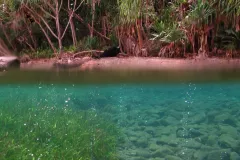Sneak Peek: Future of Coral Reefs in an Acidifying Ocean

Scientists don’t often get the opportunity to travel through time. But nestled among the beautiful coral reefs of Papua New Guinea (PNG) is a place that provides a glimpse today of what could be the biggest future threat to coral reef survival: ocean acidification. Ocean acidification is occurring because the ocean has absorbed about a third of the carbon dioxide (CO2) released into the atmosphere from the burning of fossil fuels. That carbon is changing the chemistry of the ocean, making seawater more acidic. Reef biologists expect this to be a bigger and bigger problem as more and more CO2 enters the atmosphere.
Normanby Island is a kind of “time vortex” where we can witness how reefs might respond to acidifying oceans. Here cool carbon dioxide naturally bubbles out of volcanic cracks in the shallow sea floor. Away from the CO2 seeps the water has a pH that is normal for modern day oceans, but as you swim closer to the seeps the water gets more and more acidic. I was fortunate to join scientists from the Australian Institute of Marine Science who are using this natural pH gradient to peer into the future.
As I first plunge into this bubble bath I understand why they named the nearby village Ili Ili Bua Bua (Water Water Bubble Bubble in the local dialect). On the shallow seafloor, I am struck by the lunar underwater landscape—the coral reef looks like none other I have seen. Instead of the usually beautiful, lively, colorful and complex scenery that I have seen in other parts of the world, massive brownish boulder corals have colonized the sea floor as far as the eye can see. There is almost no trace of the fragile branching corals that are home to so many underwater creatures elsewhere. Even the abundant and colorful fish seem to have abandoned the place. Closer to the most intense vents where water is most acidic, corals have stopped growing altogether; they have been replaced by sand, rubble and algae beds.
Where have all the beautiful corals and fish gone? When the ocean absorbs all that CO2, either from seeps like the ones in PNG or from the atmosphere, it dissolves and combines with water molecules to form carbonic acid. Ocean acidification directly harms many species with a calcareous shell or skeleton, such as mollusks and corals, by lowering the availability of calcium carbonate that they need to build their homes and structures. But other organisms that shelter in corals reefs are also threatened. Think of the coral reef as an apartment block made of chalk and the acidifying seawater as vinegar—when you pour vinegar over chalk, it dissolves away the walls of your apartment block, providing less and less livable area for the resident species. The result, especially when combined with bleaching from warming waters, could mean the collapse of coral reefs.
Here at Water Water Bubble Bubble, we can travel through time—in a five minute swim we see the steps of reef acidification expected for the twenty-first century. These reefs beg the question: will we be able to control our CO2 emissions before the point of no return?
Editor's note: Read more about ocean acidification, coral reefs and how you can help them.

